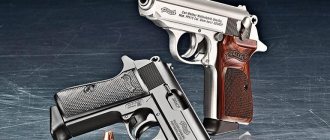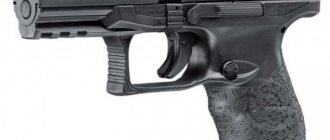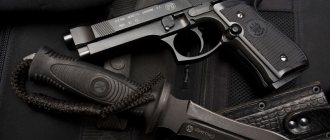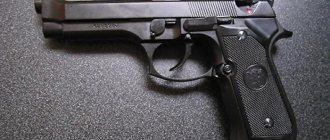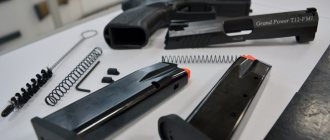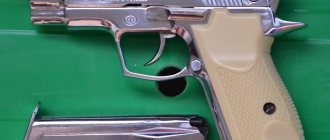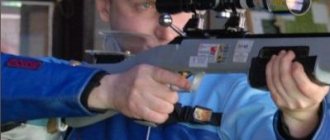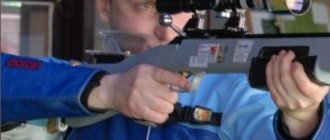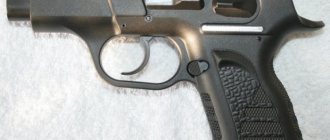The Walther P99 pistol has a deep history. The Walter brothers company mainly produced classic models of pistols with steel frames. For example, the Walther P38, one of the most powerful pistols of the Second World War, is still produced and the conservative approach in the development of pistols did not let the company down until 1988, when the P88 was released, which was not a commercial success due to its high price, this prompted the company to start production pistols with new design solutions.
The history of the Walther P99 pistol
The company Carl Walther Sportwaffen GmbH was founded in 1886 and is known as a manufacturer of first-class weapons characterized by high quality workmanship. In 1990, it began developing a project (hammerless pistol) and just five years later the Walther p99 pistol was demonstrated at the IWA'95 exhibition and was immediately appreciated.
In contrast to earlier steel frame models, German gunsmiths under the leadership of Horst Weps and Peter Dahlhammer emphasized technological and design advances. While many manufacturers, pursuing their goals when developing new models, often neglect convenience and aesthetics in favor of reliability, the P99 has excellent ergonomics, less weight due to the use of composite materials, is quite reliable, compact and is available in several versions that differ in the trigger mechanism and features his works.
Linear range of P99 models
At the moment, there are only a few modifications of Walter available for free purchase and a number of pistols produced in accordance with the requirements of the special services:
- WaltherP99Q for the German police and its special chemically hardened version PPQNavy intended for water and maritime special services (WSP, or WaPo). Sea water does not harm such hardened weapons in any way.
- P99 (AntiStress) or P99AS. The name speaks for itself, due to the use of a double-action trigger, the idle stroke before the first press of the trigger is very long, which can prevent an accidental shot.
- P99QA (Quick-action) - a model that differs from AS in that the trigger force is constant, the firing pin is constantly in an almost cocked position (like a Glock).
- The WaltherP99 DAO (DoubleAction Only) is a double action only trigger and there is no firing pin release key.
As usual, after commercial success, copies were released following modifications.
A shortened copy - P99 compact (Walther) was demonstrated at the world's largest exhibition "SHOT Show" in 2004. Like the base model, the compact was praised for its convenience, reliability, accuracy and quality. For the sake of compactness, we had to sacrifice an increase in toss when firing. But those who bought the P99c for self-defense and shooting were very pleased with the purchase, especially highlighting the German quality, ease of wearing and excellent accuracy.
All models in this series are equipped with ten- and fifteen-round magazines. Versions of magazines with and without finger rests are available. The larger 15-round magazine is equipped with an adapter allowing the handle to be extended to classic sizes.
p99Walter, (pneumatic) - a pneumatic copy, with a shortened handle and barrel, used mainly by novice athletes to learn shooting skills. Perfectly imitates the operation of the original firearm. Magazine for 18 balls.
Walter P-99 (Germany). **************************************** ************* The development of the P-99 pistol was started by Walther (Carl Walther SportwaffenGmbH.) in 1994. The main goal was to create a modern pistol for police and citizens, capable of achieving greater success in the civilian and service weapon markets than its predecessor, the Walther P-88, which, despite its excellent characteristics, turned out to be too expensive to produce. The creation of the “P-99” was completed by 1996, and the result was the “Walther P-99” Pistol in a gift (souvenir) version. In European countries for some reason such pistols are called “hunting”. The photo below shows the same thing, but with different engraving options.
.
quite successful. For brevity, we will henceforth call it “R-99”. Any, the most modern weapon, in the process of many years
Pistol "Walther P-99" in a gift (souvenir) version.
.
use becomes obsolete, not so much physically as morally. Application experience reveals its strengths and weaknesses. Production technology and materials science are developing so rapidly that they do not allow designers and technologists to stand in one place. Pistol "Walther P-99" in gift (souvenir) version.
.
New times pose new challenges that require solutions. Among such traditional and priority requirements as reliability and safety, new ones have appeared - increased survivability and ergonomics. By the survivability of personal weapons, we have long been accustomed to mean the number of shots that can be fired from it and at the same time it should not lose its ballistic characteristics. Each type of weapon has its own survivability, if for a combat pistol it is The back wall of the polymer handle is removable for a better fit to the hand.
is about 25-35 thousand shots, then service and civilian
weapons should withstand 10-12 thousand shots. Thus, the durability of service weapons, which suits the federal and state police of the Federal Republic of Germany, is 10 thousand shots, and some quickly wearing parts, such as the firing pin, springs, must withstand at least 5 thousand shots/cycles without replacement. This number also includes the so-called “idle work” - training exercises with controls. There are currently three main models of pistols in the German police arsenal. These are “P-6” from SIG-Sauer (P-225), “P-7” from Heclker & Koch and “P-5” from S. Walther, which are due to be replaced in the near future for various reasons. The appearance of the new “Walter” turned out to be very timely in this regard , a prototype of which attracted the close attention of law enforcement agencies even at the International Arms Exhibition in Munich. A weapon of a fundamentally new design, such as the R-99 model, was created in record time. The first shot was fired on January 4, 1994, less than two years after work began. The new pistol was conceived in 1992 by specialists from the banks of the Danube as a service weapon for the police, security services and citizens - the 9x19mm Parabellum ammunition or the 9x21mm IMI cartridge predominates in Germany and its neighboring countries . In the USA, preference is given to the 10mm .40 Smith & Wesson cartridge (.40 SW, 10x22m). Since September 1993, 56-year-old engineer Horst Been (Horst Wesp), a native of Austria, has become responsible for new developments at the S. Walther company. The number 1 in this photo indicates the rectangular protrusion of the barrel and bolt coupling mechanism. The number 2 indicates a window with a button for removing the pistol from pre-cocking.
In just two years (1992-1994), a whole series
of predecessors to the new “Walter” was created. In the outlines of the first hand-made sample, the features of today's model were already visible. However, its handle in its shape resembled the Colt All American pistol, and the double trigger tongue was similar to the G. Glock pistol. The next stage was the creation of the first working sample of a hammerless pistol with a new frame and handle design. Finally, a prototype appeared - the Model M, the predecessor of the future Walther P-99 serial pistol. Between these three stages, numerous design studies were carried out on wood and metal samples, which were intended to create software for CNC machines. At the beginning, the new project was given the name “Hammerless Pistol” (“hammerless pistol”, English). The abbreviation "HLP" would add to the already existing range of product designations, "РРК" (service weapon); “OSP”, “GSP”, “CPM”... (sporting weapons). In the end, the new pistol was named “R-99” (“P-99”), thanks to which it began to be perceived as a continuation of the series of military weapons following the “R-88” and “PP-90”. However, this is the only thing that unites it with previous models of large-caliber pistols of the Walter family. A decisive step was required on the part of the management of the company S. Walther, which in April 1993 became part of the Umarex concern (Umarex, Germany), because the R-99 was originally conceived for the market of service and civilian weapons under the most common cartridge – “9 mm Parabellum” (9×19), where there is fierce competition for the buyer. Given these initial conditions, S. Walther had to create something special in order to stand out from the crowd. One of the reasons for the sensational nature of the new model is its break with the traditional design and materials used in Ulm gunsmithing . The first thing that catches your eye is the handle made of polymer material, which many people still look at with prejudice. Whether the adherents of the old want it or not, the familiar all- metal short-barreled weapon is gradually moving away.
The Walther P-99 pistol.
The top photos show the head of the signal protrusion in the recess (circled), the bottom photo shows the muzzle.
.
into the past (although, of course, it cannot be completely “dismissed” from accounts
). Many large and small arms manufacturers are now taking the path proposed by Gaston Glock (Austria), who created his “safe-action-pistole”. These are Smith-Wesson with its Sigma , and Heckler & Koch with its USP, which is making new attempts to capture this market niche after the failure to introduce the VP-70 model pistol in the 70s. Czech gunsmiths also do not remain in debt, having presented a pistol of the “DAO” type (“DAO”), models “CZ 100” and “CZ 101”, similar in materials used Walter company specialists managed to avoid a design that would be a repetition of a well-forgotten old one or just a different combination of well-known solutions that do not provide tangible novelty and effect, which can be observed in the numerous releases of “new” weapons in recent years. While developing the P-99 pistol, designers from Ulm an der Donau found a fundamentally new and sure path to success. Ease of use, the absence of unnecessary controls and complex safety mechanisms, a combination of elements of self-cocking and impact mechanisms - these are the undoubted advantages of the new model. And all this, combined with new technology and high precision manufacturing, guarantees the high quality of the new model. Polymers are now not only strong enough. It is also important that the manufacture of parts from them requires significantly less time and energy, and the labor intensity of production is reduced. In addition, the introduction of special impurities into certain areas of parts makes it possible to locally change their strength. Thus, glass microbeads improve sliding, and carbon fiber strengthens the material of parts subject to increased loads, such as the trigger or magazine latch. The metal elements of the guides installed in the frame are spaced apart from each other at the maximum possible distance. They are made in the form of brackets and are firmly connected to the polymer base of the frame. Over time, the weapon number began to be stamped on the rear bracket (it should be on both metal and polymer parts). Sometimes on the frame you can see the index “Model M”, this means that this is a model from a series intended for factory testing, the predecessor to the serial production of the P-99 pistol. The frame is made of polymer plastic to reduce the overall weight of the pistol. The weight of the “R-99” with a magazine without cartridges is just under 700 g, of which only 167 g is on the frame (with a handle), but without a magazine. The frame of the pistol is black or dark green (in the “military” version) or “camouflage” coloring. A characteristic feature of the “R-99” is that the rear part of the grip is removable, and three (3) interchangeable rear parts of different sizes are supplied with the pistol - to fit the hand of each individual shooter. In addition, a recoil damper is built into the rear of the handle. On the front of the frame under the barrel, in accordance with the latest fashion, there are guides for attaching a laser pointer or flashlight. The weight of the milled metal bolt of the new pistol is about 350 g. The polymer handle also allows you to expand the number of options for the artistic design of the weapon. projections and recesses on the side and end surfaces of the handle The main thing is that the back wall of the handle is removable. As standard, the new pistol has a black neoprene insert in this area to better absorb recoil energy. Using neoprene or wooden inserts of different thicknesses, the handle can be easily adjusted to your hand. The company plans to include wooden blanks in the accessory kit , the adjustment of which is carried out by the owner of the weapon himself. The angle between the axes of the handle and the bolt is 110 degrees, while the angle of installation of the magazine relative to the axis of the barrel is five degrees less (105°), which ensures an uninterrupted supply of cartridges during firing. What is most surprising is the small thickness of the handle of the new pistol - 29 mm. At the same time, the R-99 uses a two-row magazine with 16 or 10 rounds. The wall thickness of the handle is only 4 mm. The designers equipped the R-99 with a magazine made of ordinary sheet steel weighing 82 or 74 g, depending on its capacity. Judging by the overall dimensions, its length is 180 mm; it has a 102 mm barrel and a convenient sighting line of 158.5 mm long. The height of the “R-99” is only 135 mm. The neoprene or wooden rear insert of the handle is secured with just one pin, which also serves to install a carabiner for a safety strap used by special forces. One of the authors of these lines has already had the opportunity to hold a new pistol in his hands - the impression from it is incomparable and difficult to convey. The “R-99” frame has increased material consumption, since its mass significantly affects the recoil force. In the planned version of the P-99 pistol of 10x22 caliber (.40 S&W), which appeared in the second half of 1996, only the angle of inclination of the side surfaces was changed, due to which the front part of the weapon was somewhat heavier, which compensated for the high recoil energy when using 10 mm caliber cartridges. At the rear of the frame there is an all-removable module, which includes part of the locking mechanism, the cocking and release mechanism, a reflector and a bolt stop. The main innovation of the new pistol should be the design of its trigger mechanism, made according to the “striker-mainspring” scheme in such a way that it ensures a low location of the axis of the barrel bore above the handle. It should be noted the optimal way to pre-cock the firing pin. About 9.5 mm, out of 14 mm, of the full cycle of movement of the firing pin until the moment of firing, it passes when it is pre-cocked as a result of jerking the bolt. This allows you to quickly fire a shot. Unlike other models, the “R-99” provides the opportunity to more fully use the advantages of a double-action trigger mechanism (self-cocking) on a completely new basis (Fig. 170). In the initial position, the striker spring, which is also the mainspring , is completely unloaded. After loading (jerking the bolt), the pistol is in a semi-cocked state, but not like a hammer-fired weapon that is familiar to us, when the mainspring is fully compressed. The firing pin of the new weapon occupies an intermediate position - it is pre-cocked, having passed two-thirds of its way, and the mainspring is only pressed. However, this is not visible from the position of the trigger located inside the frame. The pre-cocking of the weapon can be judged by two factors: the appearance of the red head of the firing pin signal protrusion in the recess of the rear part of the bolt, which is visible even in the dark, and a change in the position of the trigger, which moves closer to the handle. The last factor can only be detected by a very experienced eye or hand. The presence of a cartridge in the barrel is indicated by a slightly sunken elongated ejector arm and a red dot in the slightly opened bolt chute. If it is necessary to fire an immediate shot, then pressing the trigger overcomes the slight resistance of the firing mechanism. The striker moves another 5-6 mm. The estimated force required to fire a shot is about 2.0 kg (single action, “soft trigger”). The design of the trigger mechanism provides for the firing of a shot even when the firing pin occupies the extreme forward position and the mainspring is completely unloaded. To fire a shot from this position, it is now necessary to completely move (cock) the firing pin, which covers a distance of 14 mm, which requires the application of a force of 3.5 kg (double action, “hard trigger”) and thereby additionally protects against an unauthorized shot. The insignificant movement of the striker when it is placed in preliminary cocking provides another unexpected advantage. Having a special holster with a partially open barrel, you can slightly send the pistol down and then up to pre-cock the weapon. Samples of such holsters have already been developed, and they function reliably. When the shutter is pulled, the trigger rod, using the left tooth of its latch, moves the firing pin back 9.5 mm. The drummer is pre-cocked. When you press the trigger, the rounded “knee” of the trigger rod continues to push it (rod) down, and the mainspring continues to compress. Further movement of the trigger rod leads to rotation of the latch, release of the cocked firing pin and firing. When the shutter is pulled, the trigger mechanism goes into single-action mode. Thanks to the short stroke length of the striker, the P-99 pistol can be pre-cocked with a slight rearward movement of the bolt with one hand and can be fired with less force on the trigger, in single-action mode. Pre-cocking the weapon in this way requires certain skills in handling it. The magazine latch drive levers are an integral part of the trigger safety guard and are in the “flush” position with it. Above the trigger there is a collapsible pistol latch. To the right of it is the bolt stop drive lever. A very important point in the operation of the new design is the removal of the pistol from pre-cocking, which, by analogy with a hammer-fired weapon, can be equated to putting it on safety. For this purpose, on the upper left surface of the shutter body, in front of the rear sight, there is a rectangular window with a correspondingly shaped button. By pressing the thumb of the shooting hand down (or the supporting hand - when gripping with two hands), the firing pin is removed from the preliminary cocking. Thus, the weapon is insured against an unauthorized shot. When removed from pre-cocking, the safety protrusion (“tooth”), which is located on the top of the firing pin, moves until it meets the protrusion of the button. As a result, the striker moves forward and stops. Its firing pin does not extend beyond the “mirror” of the shutter, because it is additionally pressed down by the installation (rear) spring of the firing pin itself and a shot is impossible. The mainspring is completely unloaded.
When shooting, this pistol is surprisingly comfortable to hold,
which is primarily due to the optimal angle of inclination of the handle relative to the axis of the barrel, the low location of the barrel itself and the relatively low curb weight of the weapon itself - 910 or 827 g. Even with serial cartridges designed for firing only to shoot from submachine guns (type “B2”), from a pistol “R-99” than from a pistol of the “R-7” model, which also sits very deep in the hand. The trigger mechanism has a short trigger stroke , which allows you to fire quick doublets (double, two shots in a row) or a series of shots. At the same time, it is not difficult to maintain the line of sight, which ensures accurate hits during high-speed shooting. Testers tested a large number of standard ammunition with a wide variety of bullet types; ranging from a mass of 6.156 g of blunt-ended (truncated cone), semi-shelled and ending with charges of the “Sab-Sonic” type ("Sub-Sonic") weighing 9.5256 g and 10.2384 g. Even prototypes of the navel with a profiled cavity in the head part ensured trouble-free operation of the new pistol’s automation. With cartridges from the following companies: Winchester, Federal, Lapua and others, a series of 5 shots at a distance of 25 m constantly gave a stable hit with a dispersion of about 35-45 mm, and sometimes even better. The rear sight, adjustable in the horizontal plane, is installed openly and can move during the process of zeroing the weapon. Each pistol comes with four replacement front sights. Since the R-99 was conceived primarily as a service weapon, the front part of the frame has guides for installing a laser target designator (LTS). All metal surfaces of the pistol are subjected to a special heat treatment - Tenipherierung, used in the manufacture of modern weapons, which provides it with a high degree of protection against corrosion. New achievements of the S. Walther company in the field of technology made it possible to preserve both the original viscosity of the material and create the effect of bluing and polishing of the surface. The cost of a new pistol is expected to range from 1200 to 1500 DM. The Americans, who understand good weapons, liked the new development so much that Walter’s partner in Virginia, USA, in the USA, ordered a five-digit quantity as the first batch . Moreover, a pistol is currently being produced under license in the United States, differing from the P-99 model in that there is now an abbreviation on the handle and bolt, as well as a rounded trigger guard . During development, the safety of the new weapon was in the foreground. This is evidenced at least by the thoughtful arrangement of the magazine latch levers, mounted “flush” on both sides of the trigger safety guard. This arrangement of the levers has a deep meaning - in order to remove the magazine, the arrow must press the lever with the index finger, having first removed it from the trigger and thereby automatically perform safety measures. Thanks to the presence of a dual operating mode of the trigger mechanism, the release of the new “Walter” can be easily adjusted to any of its operating modes of single and double or only double action. The Walther P-99 pistol is built according to a short-stroke design. locking - according to a modified Browning scheme, where the barrel is lowered, interacting with a fixed pin in the frame, and engages with the bolt through a window for ejecting cartridges. This locking mechanism, based on a short stroke of the descending barrel, has already been successfully used on the R-88 model. The milled upper part of the frame houses the barrel and bolt coupling mechanism, which is a modified J. Browning system. The protrusion at the top of the barrel breech fits into a similar groove in the bolt window for ejecting spent cartridges. The barrel is lowered by the interaction of the profiled cam of the barrel boss with the working protrusion of the frame. Under the barrel there is a return spring made of rectangular wire, which, according to its creators, better stores energy during compression and is more compact than conventional springs made of round wire. The beveled surfaces of the bolt gave the pistol an elegant and finished appearance. The trigger mechanism is striker-fired, double-action, but a QA (Quick Action) modification is also available, in which the firing pin is always in a partially cocked state and is re-cocked with each pull of the trigger (somewhat similar to pistols
.
Pistol “Walter P-99”, incomplete disassembly...
“
Glock”), this design ensures a constant trigger pull for all shots. The pistol does not have external non-automatic safety locks; instead, there is a button for safely decocking the firing pin (located at the top of the rear of the bolt). In addition, there are three automatic safeties - blocking the firing pin when dropped, blocking the firing pin when the bolt is not closed, and an automatic safety on the trigger. According to many reviews, the R-99 is an excellent pistol, characterized by high reliability and good accuracy, especially in the version chambered for 9x19 mm Parabellum and 9x21 mm IMI cartridges. It is worth saying that the designers of the Walter company acted very smartly by stamping the general designation “9-mm” on the bolt, and not the name of the cartridge used, which gives at least small, but still good 9x19-mm caliber barrel “Parabellum” can be exchanged for a 9x21 mm “IMI” caliber barrel or vice versa). In conclusion, it is worth noting that the well-known James Bond, the unsinkable agent 007, after many years replaced the reliable, but already outdated Walther RRK with a brand new, brand new P99, which the Walther company was quick to take advantage of for advertising purposes (see the film “Tomorrow Never Dies” ” - “Tomorrow Never Dies” with Pierce Brosnan in the title role, and the following films). . Characteristics ************************************************* ************** Caliber, mm 9 mm / 10 mm Cartridge used 9x19 “Luger”, 9x21 IMI / “.40S&W” Rifling 6 grooves (right-handed) Rifling pitch, mm 250 / 400 Weight without cartridges, kg 0.7 Length, mm 180 Barrel length, mm 102 Muzzle velocity, m/s 375 Rate of fire, v/m 40 Magazine capacity, cartridges 10/10 Sighting range, m 50
general description
Walter (p99), compared to the huge arsenal of pistols, is distinguished by its modest dimensions and weight. The frame is made of polymer material, made in two colors, black and dark green. Almost all external parts of the weapon are flush and do not protrude beyond the surface of the bolt and frame. Additional butt pads are supplied with the pistol and can be changed at the shooter's request. The guides on the body allow you to install a laser target or a combat flashlight.
The muffler is also installed on the thread of the elongated barrel, but the pistol is equipped with such a barrel only by order of certain organizations.
Operating principle and design
The use of automatic fuses, a manual safety lever, and a button for safely decocking the firing pin made it possible to significantly increase the level of safety in operation of the P99. The handle is comfortable to grip, and the deep seating of the palm coupled with a short distance from the central axis of the barrel to the butt plate of the handle greatly reduces recoil, in other words, the tossing of the pistol during shooting. Weapons have been developed using recoil momentum, which also reduces the toss.
According to the “Browning” scheme, p99 implements a barrel bore locking mechanism, when when fired, the cartridge case remains locked in the chamber with an offset barrel, and in Browning, a figured cutout under the breech interacts with a pin in the frame. Engagement with the bolt occurs through a special window in the receiver for ejecting spent cartridges. The barrel is made with polygonal rifling. The spring-loaded barrel lock serves as a limiter for the forward movement of the moving system. When disassembling and assembling the pistol, the locking mechanism is also the key.
Replaceable handle elements
The shutter is made of alloy steel and is covered with a polymer cover at the back. The return mechanism is classic, consisting of a steel spring and a polymer guide rod. The composite frame material is polymer with the addition of fiberglass and complemented with metal inserts. In addition to the pistol, three interchangeable butt pads are included, adjustable by a protrusion on top of the handle and a pin on the bottom.
The pistol does not have non-automatic safety locks. Such fuses had already been previously used on the Glock models - Australia and the American Sigma, but the designers, when developing the Walter (p99), improved the safety of handling the pistol. The shot is fired either self-cocking or with a pre-cocked firing pin. The firing pin release lever, typically found on combat pistols, has been replaced by a button in the P99. When pressed, the trigger takes on a “self-cocking”, safer position. There is also a barrel lock on the frame.
The firing pin shank protrudes slightly from the rear of the pistol, indicating that there are cartridges in the chamber. The Walter is fed by a two-row magazine, the polymer protruding cover of which helps speed up its replacement.
Technical characteristics (TTX) Walther p99
| Weight without cartridges, kg | 0.63 |
| Gun length, mm | 180 |
| Barrel length, mm | 102 |
| Width, mm | 29 |
| Height, mm | 135 |
| Cartridge | 9×19 mm Parabellum |
| Work principles | Recoil with short barrel stroke |
| Initial bullet speed m/s | 375 |
| Type of ammunition | 16-round magazine (9mm), 12 rounds (.40) |
In addition to the 9x19 parabellum cartridge, versions of the pistol were manufactured for 9x21 parabellum and .40S&W (Smith & Wesson). If the 9-mm P99 has a magazine for 16 rounds, then the 10-mm version has 12 rounds.
Assembly, disassembly and care
Umarex Walther CP99 Disassembly and assembly
Performance characteristics of the Walther P99c pistol
- Caliber: 9mm Parabellum
- Weapon length: 168 mm
- Barrel length: 90 mm
- Weapon height: 110 mm
- Weapon width: 32 mm
- Weight without cartridges: 530 g
- Magazine capacity: 10 rounds
Pistols
- Israel
- Spain
- Mexico
- South Korea
- Slovakia
- South Africa
- Montenegro
- Croatia
- Japan
- Norway
- Ukraine
- Vietnam
- USA
- Great Britain
- Finland
- Hungary
- Germany
- Serbia
- Switzerland
- Poland
- France
- Belgium
- Italy
- Austria
- Russia/USSR
- Brazil
- Türkiye
- Argentina
- Canada
- UAE
- Jordan
- China
- Bulgaria
- Slovenia
- Czech
Owner reviews
This is what P99 owners say: “I’ve been using this pistol for seven years, although the model is outdated, I’m 100% satisfied with it! There are completely no signs of wear, and this is after several thousand shots, not a single misfire.” “The quality of the material is excellent. The palm lies on the handle like a glove. The shutter surface is not scratched. Precise, ergonomic, elegant, lightweight and safe. Excellent soft trigger and well controlled recoil."
The weapon is valued not only among amateurs, but also among professional shooters. According to the shooter who competed at the IPSC competition, he fired about 70 thousand shots from his P99 and after the barrel lock broke, he contacted the manufacturer and they exchanged it for a brand new pistol without any problems.
Walther p99 test shooting results
During tests simulating practically impossible life situations with the P99, 250 thousand powerful cartridges were fired. Rapid firing was carried out in the temperature range from −45C to +75C and, apart from the periodic change of the steel spring and magazine spring, all the main components of the pistol remained intact. When tested by dropping a loaded and cocked pistol onto different surfaces, no shot was fired.
Such stress tests fully proved the reliability of the P99, which made it possible to put it into service in various modifications with the German police, GSG9 (special forces unit of the German Federal Police), Finland and Poland.
After the arrival of the P99 in 2005, it became clear to the North Rhine-Westphalia police that the P99 holster, due to its size, was difficult to fit in some patrol vehicles. As a result, the police were given permission to wear a holster on their belts, and the seat belts were replaced.
Walther P22T, PP, P99T, P50T
Walther P22T
Gas pistol with the ability to fire rubber bullet cartridges Walther P22T is produced by the German company Umarex. The pistol is similar in appearance to the sporting Walther P22 chambered for .22lr caliber. The Walther P22T traumatic pistol chambered for the 10x22T traumatic action cartridge appeared in Russia in July 2004. The pistol has a modern design and good ergonomics, but it is not the best in its class. The bolt and trigger mechanism (trigger) are made of an aluminum-based alloy. The pistol frame is made of polymers. As a result, the pistol turned out to be unusually light - only 430 grams. But at the same time, the Walther P22T is very fragile. It is not recommended to use powerful cartridges in the pistol; therefore, it becomes completely unsuitable for self-defense. Initially, the pistol had to be certified as a barrelless firearm, which is why it does not have a barrel as such. Instead of a barrel, there is a thin-walled steel tube - a false barrel, which has cuts in the side walls to reduce pressure and prevent the rupture of this very false barrel. Inside the false barrel there is a guide for imparting linear movement to the rubber ball. The guide has the form of a tube rolled from a sheet of metal with a diameter of about 3 mm and is located parallel to the lower wall of the false barrel. In a plastic frame, two pins also rolled from sheet metal secure an assembly, including a trigger, and a chamber, to which a false barrel is attached with a steel pin. The assembly itself is made of two halves fastened with two screws. The chamber immediately behind the “bullet entrance” has a narrowing that forms a gap about 7 mm wide and about 4 mm high. This gap prevents the pistol from being fired with a solid body and ensures the operation of the automation by creating back pressure. The mainspring of the trigger works not in compression, but in tension, which also negatively affects the service life of the pistol. Trigger trigger trigger pistol, double action. An original, but absolutely useless element is the trigger lock, which is activated by turning the key of the pistol included in the kit. The frame also contains a magazine latch, located at the base of the trigger guard and having an original design. It is very convenient for both right-handed and left-handed people and prevents the magazine from falling out when worn in a holster due to accidental pressing, as is possible with pistols with a “push-button” magazine latch. There is also a plastic latch on the frame that serves to disassemble the pistol. The problem with the first releases of the pistol - self-disassembly during the firing process - was due to the fault of this very latch, which, when the bolt struck, fell to the lower position and the bolt flew off the guides. The disease was cured by drilling through the frame and latch and driving a steel pin into the hole, which is now standard on all pistols (it is because of this pin that the pistol cannot be disassembled without tools). Early releases of the pistol had through grooves on the bolt located on the side faces of the bolt closer to the muzzle. These grooves were made to weaken the design of the pistol and eliminate the possibility of firing more powerful ammunition. As a result, the design turned out to be so weakened that the bolts were destroyed (the front part of the bolt casing was torn off) even from standard ammunition. Pistols of later production differ from early production by the absence of grooves on the slide and the modified shape of the magazine base. The drummer is steel, spring-loaded and, as a rule, does not cause any complaints. The fuse has a design traditional for German gas pistols; it does not block the trigger, but only separates the trigger and the firing pin. The ejector is steel, stamped. It is necessary to pay attention to the ejector axis, since it is a pin that over time begins to fall inside the bolt and may fall out. Food is supplied from a detachable box magazine with a capacity of 7 rounds. The magazine is steel, the feeder is cast from an alloy, the base of the magazine is plastic. The sights are open and fixed. It is possible to install a laser target designator (LTC) on special grooves in the front part of the pistol frame. Performance characteristics: Caliber: 10x22T Magazine capacity: 7 rounds Dimensions (LxHxW): 159x114x29mm Weight: 430g Walther PP Gas pistol with the ability to fire rubber bullet cartridges Walther PP was produced by the German company Umarex. This pistol appeared in Russia in the summer of 2005. Walther PP is a conversion of the Walther PP gas pistol for the traumatic action cartridge of 10x22T caliber. Both of these pistols externally resemble their ancestor - the German PP combat pistol from Walter. The design of the pistol is entirely made of TsAM alloy (zinc, aluminum, copper). As a result, Walther PP turned out to be very fragile. A steel liner is installed in the barrel. In order to prevent shooting with a heavy object, barriers (“teeth”) are installed in the barrel, one at the bottom near the chamber and three rectangular at the muzzle. This arrangement of obstacles negatively affects the basic qualities of the pistol.
View of obstacles in the barrel of a Walther PP pistol
The automatic operation of the pistol operates on the basis of free movement of the bolt. The trigger mechanism (trigger mechanism) is hammer-operated, double-action. It is worth mentioning that the trigger is also made of alloy. The fuse is a flag fuse; to switch it to the “fire” state, the flag must be moved up. Food is supplied from a detachable box magazine with a capacity of 7 rounds. The magazine release is made in the form of a button on the left side of the pistol. The sights are open and non-adjustable. The weak design and small capacity of the pistol magazine have already been mentioned, but there are other shortcomings. Due to the use of alloys in the manufacture of the pistol, firing powerful cartridges is not allowed, which negates the self-defense qualities of the Walther PP. The parts and mechanisms of the pistol wear out very quickly, breakdowns often occur, and there is no way to repair it due to the lack of spare parts. The only advantages include ease of reloading and similarity to a historical model, which certainly attracts history buffs. Performance characteristics: Caliber: 10x22T Magazine capacity: 7 rounds Dimensions (LxHxW): 170x110x30mm Weight: 600g
Walther P99T Gas pistol with the ability to fire rubber bullet cartridges Walther P99T is produced by the German company Umarex. The pistol is manufactured by converting a Walther P99 gas pistol for a traumatic cartridge of 10x22T caliber. Both resemble the Walther P99 combat pistol in appearance. The traumatic Walther P99T appeared on the domestic traumatic weapon market simultaneously with the Walther PP (mentioned above) at the end of the summer of 2005. Based on the manufacturing materials, the Walther P99T repeats its “younger brother” Walther P22T. That is, the shutter and trigger are made of an aluminum-based alloy, the frame is made of polymer. Accordingly, the old problems remain - unreliability, rapid wear of parts and mechanisms, inaccessibility of spare parts, the need to use a low-power cartridge so that the pistol does not break into pieces. The Walther P99T differs from the P22T in its increased dimensions and increased magazine capacity to 15 rounds. Comparing photos of these two pistols, you can easily notice that the Walther P99T has a hidden trigger, which can be smoothly released using a special key on the rear of the pistol's slide. You can also notice the absence of a manual fuse. The Walther P99T has automatic fuses that block different parts of the trigger. Performance characteristics: Caliber: 10x22T Magazine capacity: 15 rounds Dimensions (LxWxH): 180x136x29mm Weight: 650g Walther P50T
A gas pistol with the ability to fire rubber bullet cartridges, Walther P50T, is produced by the German company Umarex. The pistol is made on the basis of another brainchild of Umarex - the traumatic Walther P22T (mentioned above). The pistol appeared on the domestic market in 2008. In general, the Walther P50T is the same as the Walther P22T, but the significant difference is that the P50T has a steel shutter. The remaining parts and mechanisms remain the same - the trigger is made of an aluminum-based alloy, the frame is made of polymer. The design description and automation operation are completely identical to the Walther P22T. A magazine with a capacity of 7 rounds is also from the above-mentioned pistol. One of the positive innovations is the presence of a laser center in the basic configuration. Thanks to the steel bolt, the Walther P50T was able to use more powerful cartridges (35-50J), but wear on alloy trigger parts is still high. Performance characteristics: Caliber: 10x22T Magazine capacity: 7 rounds Dimensions (LxHxW): 159x114x29mm Weight: 450g
Source
Tag: Weapons_Catalog_of_weapons_Traumatic_weapons Discuss the article on the forum
